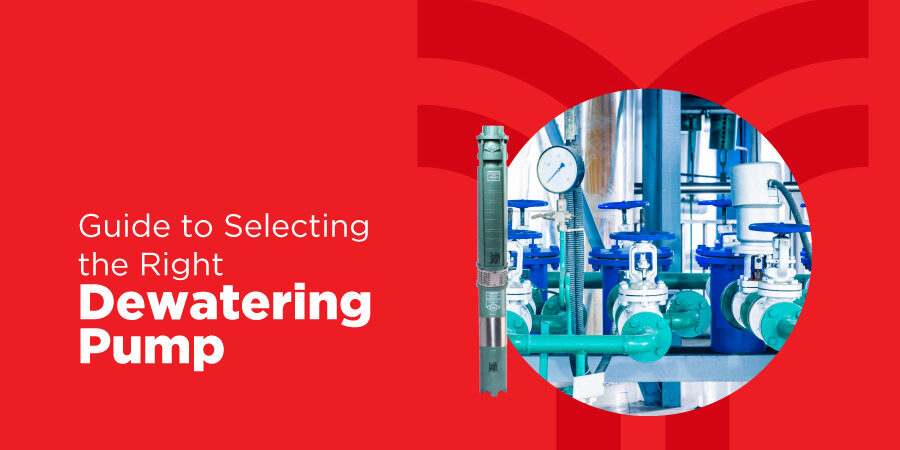A Comprehensive Guide to Selecting the Right Dewatering Pump
Wastewater accumulation is one of the painful problems in many industries. It demands laborious work that consumes time and money. According to the US geological survey, accumulation related problems account for billions of dollars in damages annually. So, to address and manage this problem is very important. The usual sites, where this problem exists are
- Construction sites
- Mining areas
- Flooded Residential areas
According to a market research future report, the Global deep watering pump market is projected to reach 6 billion by 2027. This is mainly because of the demand from the above mentioned areas.
To effectively manage water accumulation in various applications, choosing the correct dewatering pump from the pump manufacturers in coimbatore is important. In this blog you can learn the key considerations and factors to keep in mind during the selection process.
Understanding Dewatering Pumps
Let us first understand the fundamental concepts of a dewatering pump and its functionality. They are specialised devices exclusively designed to remove the excess water from different environments. It can work wonderfully in shallow puddles and also in deep excavation sites. It operates by creating a section force to draw water into the pump and then discharge it by expelling it through a hose or pipe.
Types of Dewatering Pumps
There are different kinds of dewatering pumps. Every different one suits specific applications and conditions.
Submersible Pumps:
Submersible pumps are designed to be fully submerged in water. It can be used in situations when the water level is relatively high. These pipes can be commonly seen in some pits, drainage systems and sewage bypass operations.
Centrifugal Pumps:
These pumps are used when water has to be prepared from one location to another. As the name suggests these pumps use centrifugal force. They are in high demand wherever there is a growing industrialisation and urbanisation is taking place. According to Grand view research the centre if you will pump size market is expected to reach 48 billion by 2027.
Diaphragm Pumps:
These pumps use a flexible diaperham inside them. It is responsible to create suction and discharge water. It is suitable to pump abrasive and viscous fluids. It can also handle solids and give protection from clogging. They are commonly used in industrial settings, wastewater treatment plants and mining operations.
Trash Pumps:
These are designed and manufactured to handle large volumes of water that contains solid debris such as rock, sand and gravel. They are used in challenging situations such as emergency flood response construction site dewatering and pond drainage. It provides faster and effective removal of water to maintain safety and operation efficiency.
Factors to Consider
When selecting a deep watering pump, it is important to have the below critical factors in your checklist.
Flow Rate:
This factor helps in the determination of the volume of water it can move at a given time frame. It is essential to know the flowrate of a dewatering pipe, to match the desired level of water. Understand how soon the water should be removed and then look for the flowrate that can be required.
Head Pressure:
This refers to the vertical distance that a pump can lift water. So to choose the appropriate one it is good to know information such as the depth of the water table or the height to wish the water needs to be pumped before selecting one.
Power Source:
Dewatering pumps are powered by electricity from different sources. Some of them are electricity diesel gasoline and solar energy .You can choose a day watering pump with a particular power source considering factors such as the availability cost and environmental considerations. Solar pumps are trending according to the International Energy agency and they are expected to account for a Power capacity of 70% in 2030.
Portability:
Understand the nature of your project and so you can understand the level of portability required. If you have to move the pumps from place to place, look for lightweight ones so that you can transport them easily.
Durability and Reliability:
Dewatering pumps in general are subjected to harsh operating conditions. It is always exposed to water abrasives and chemicals. So, it is important to choose a pump that is made of high-quality materials and has protective properties such as corrosion resistance.
Maintenance Requirements:
Talk to the manufacturer and learn about the maintenance and needs of the pump. You should be aware of the routine inspections, lubrication and cleaning. This can minimise the downtime and ensure uninterrupted operation during any of your projects.
Conclusion
Finally, choosing the right dewatering pump is one of the crucial steps to ensure success in efficiency in any project that involves water management. By understanding the different types of pumps available and the factors to consider before making the purchase decision can lead to wonderful outcomes. If you need more information you can always consult experts and reputable water pump manufacturers to ensure optimal performance reliability and efficiency throughout the project lifecycle.


